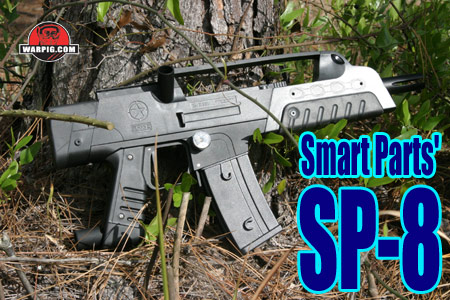  |
|
|
|
|
|
|
  |
|
|
|
|
|
|

What
do you think?
|

SP-8 By Bill Mills - Photos by Dawn Mills - Apr 2006 Overview Overview - How It Works - Disassembly - Testing - Raw Test Data The first person we saw at the 2005 PSP Paintball World Cup was Bill Gardner, Jr. from Smart Parts. We ran into Bill before even getting out of the parking lot, and when he saw us his face lit up like a child excited about a Daisy Red Rider 200 shot repeater range model air rifle under the Christmas tree.
Functionally, the SP-8 is basically an ion in a new body cover, much as its colored body covers can be replaced, the clamshell body of the SP-8 fits over a metal receiver that is the equivalent of the Ion's, and mates to a more complex grip frame.
At the top of the SP-8 is a Picatiny style sight rail with an open center. This slotted rail accepts sights and accessories set up for military or hunting use. The XM-8 is actually designed to use sights that integrate into the body shape locking onto the rail – if and when some of these become available to the public they will likely be a perfect fit on the SP-8, but include a rather hefty price tag. Beside the sight rail, on the right hand side is the SP-8’s feedneck, angled at 45 degrees from vertical. The feedneck is a part that fits into the upper receiver body, and guides paint down to the breech of the aluminum receiver inside.
Moving forward along the top of the SP-8 one finds the carry handle, a piece which extends from the sight rail to a raised section of the foregrip. Immediately below the carry handle is the charging handle. On the XM-8, this handle is used to cock the mechanism and chamber the first round of a freshly loaded magazine. The SP-8 doesn’t need a charging handle because its electropneumatic valve system is self-cocking, however the SP-8’s charging handle is more than just decoration. The handle is actually a clamp, which slides onto rails in the top of the receiver halves. It serves to hold the to receiver halves together, and to cover their seam preventing the entry of dirt or rain. A peg underneath the front of the handle keeps it locked in place until the foregrip is removed.
At either end of these cosmetic vents is a pair of screw holes, which allow for the mounting of accessory rails. On the bottom of the foregrip, near its front are another pair of holes, these with threaded metal inserts inside. The two bottom holes allow for the mounting of an additional reail, bipod, or other similar underbarrel mil-spec accessory.
The SM-8 uses the same style of threading as the Smart-Parts Ion and Impulse, which means that most Ion/Impulse barrels will work with it, as long as they fit within the shroud.
Near the back of the foregrip, is a single aluminum push-pin which locks the foregrip in place. An o-ring resting in a groove on the pin gives it friction to prevent it from falling loose.
The regulator screws into an ASA that is integral to the magazine receiver. Sitting inside the ASA is a fine mesh filter, designed to protect the internal solenoid valve from debris. Because a standard ASA fitting is used, a variety of aftermarket regulators is available as options for SP-8 owners.
Velocity adjustment is achieved by twisting the wrench flats at the bottom of the regulator. On the right hand side of the grip frame is a compact low pressure gauge, like that found on the Ion, which can be used to monitor the pressure of gas fed to the solenoid valve and exhaust valve.
Knowing the regulator’s output pressure is important, as levels above 200 psi can damage internal components and void the SP-8’s warranty.
A magnetic attract style trigger return provides a trigger pull that is solid enough to avoid accidental discharge, but becomes lighter as the trigger is pulled further back.
Inside the grip frame, the SP-8’s circuit board is programmed to provide four different modes of fire. A true semi-automatic mode fires one shot per trigger pull. Rebound modes add additional shots after a few shots have been fired at a minimum rate, providing an effect similar to the original Smart Parts Turbo mode. The three shot burst mode fires a burst of three shots when the trigger is pulled, and full automatic fires repeatedly while the trigger is held down. Since the ability to change modes requires tools to open the SP-8’s wraparound grips, the paintgun is locked on field into whichever mode it is set, making it legal to use on tournaments or fields which restrict play to semi-auto or ramping modes only.
The power switch is also used to activate or deactivate the SP-8’s break beam anti-chop “eye” system. On either side of the breech, an infra-red emitter and detector are wired into the control circuitry so the SP-8 will wait until a paintball has fed before it fires, reducing the chance of chopped paintballs due to mis-feeds. Continue to How It Works |
| Copyright © 1992-2019
Corinthian Media Services. WARPIG's webmasters can be reached through our feedback form. All articles and images are copyrighted and may not be redistributed without the written permission of their original creators and Corinthian Media Services. The WARPIG paintball page is a collection of information and pointers to sources from around the internet and other locations. As such, Corinthian Media Services makes no claims to the trustworthiness or reliability of said information. The information contained in, and referenced by WARPIG, should not be used as a substitute for safety information from trained professionals in the paintball industry. |